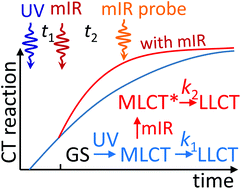Electron transfer rate modulation in a compact Re(i) donor–acceptor complex
Abstract
Formation of the charge transfer state with the rate constant of (10 ps)−1 has recently been reported for the complex fac-[ReI(CO)3(DCEB)(3DMABN)] (ReEBA); where 3DMABN is 3-dimethylaminobenzonitrile, serving as an electron donor, and DCEB is 4,4′-(dicarboxyethyl)-2,2-bipyridine, serving as an electron acceptor (Y. Yue et al., J. Phys. Chem. A, 118, 10407). 3-Pulse UV-pump – IR-pump – IR-probe spectroscopy is used in this work to study how the charge separation reaction in ReEBA to form a ligand to ligand charge transfer state (LLCT) can be modulated by vibrational excitation of various modes of the complex. While no significant rate modulation was found when the cyano group stretching mode of the 3DMABN donor was excited, a sizable effect was found when the ring stretching mode of the DCEB acceptor was excited. The accumulation of the charge separated state (LLCT state) in the 3-pulse experiment was observed as a sharp excited-state vibrational peak of the symmetric stretch of the three facial carbonyl groups, νSS(CO). Modeling indicates that the rate of charge separation is increased by ca. 28% when vibrational excitation is present. The vibronic coupling signal of the bpy ring mode and νSS(CO) as well as the energy transport dynamics from bpy to carbonyl contributed to the 3-pulse signal and was studied as well using the 3-pulse method. Energy transport between the same modes in the ground electronic state was measured by relaxation-assisted two-dimensional infrared (RA 2DIR) spectroscopy. The energy transport times of 4 ± 0.7 and 5 ± 1.5 ps were found for the ground and excited electronic states.

- This article is part of the themed collection: Spectroscopy of Inorganic Excited States

 Please wait while we load your content...
Please wait while we load your content...